7 Examples of Marketing Theories Every Marketer Should Know
Marketing is not just a profession about creation, but it is also about science and it relies on how your business understands marketplace data and takes advantage of them. Here are ten marketing theories worth learning to help any marketers to make the right decisions, and bring out more effective plans.
Marketing Mix
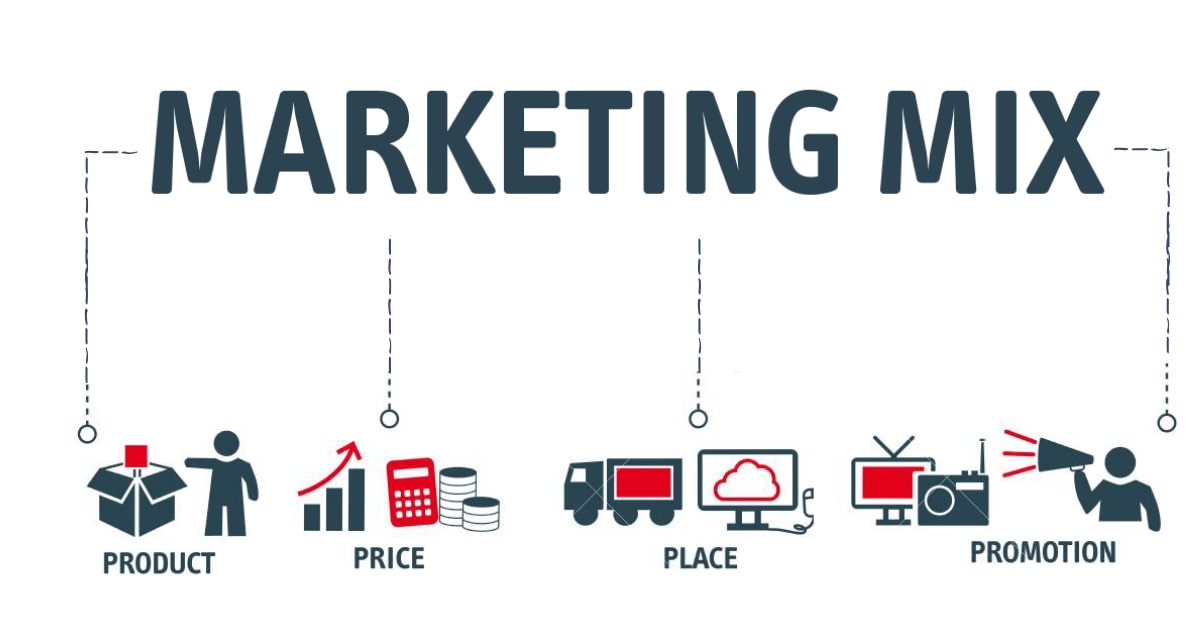
Marketing Mix Definition
Marketing mix is a set of marketing tools used by an enterprise to achieve its marketing goals in the market.
Marketing Mix capital is classified under the 4P model including: Product (product), Price (price), Place (distribution), Promotion (promotion) is used in goods marketing. Over time, this model has evolved into 7P marketing according to modern marketing’s complexity and innovation.
Marketing experts have come up with another 3P, Process, People, and Physical Evidence, that power marketing when the product is no longer in stock.
Marketing Mix plays a critical role in the business model of the business. This is the bridge between the buyer and the seller, which helps the seller understand the buyer’s real needs to satisfy most optimally and, base on that, to plan the appropriate marketing programs.
How Does Marketing Mix Work?
Marketing Mix 4P

4P is the traditional Marketing Mix strategy. This model was built in the 1960s by economist E. Jerome McCarthy.
From that time, the 4P Marketing model became famous and used, and taught in businesses, universities and colleges around the world.
The Marketing Mix 4P model is also the foundation for the Marketing Mix concept in general. Marketing Mix 4P is a set of marketing areas that include:
Product
Product is a very important element in the 4Ps model. Products are created to satisfy the needs of a specific group of customers. Product may be tangible or intangible (presented as a service).
A product life cycle (cycle) consists of Introduction, Development (growth), Maturity (maturity), Decline.
The identification of customer needs is extremely important, it helps you balance the source.
Price
Price is a very important aspect of Marketing Mix. Here, you need to define a price that customers (in the customer file you have chosen) will feel satisfied with when they open their payment accounts.
This is clearly an extremely sensitive strategy. Let’s say that you want to offer a completely new product. But it’s not when you set a very high price for a product. But the company providing such products has not built a lot of reputation in the market.
When determining the selling price, marketers should consider the value the customer receives for a product. There are three main pricing strategies, including: Market penetration pricing, Market skimming pricing (skimming pricing), Neutral pricing (neutral pricing).
Place (location)
The distribution system is another crucial aspect of the Marketing Mix. You need to consider building a system that provides the right product/service, helping customers be convenient in consumption.
You need to have a deep understanding of the market in which your business supplies products. This will help you discover the necessary properties. To satisfy customers in that market.
There are different distribution strategies, including Intensive distribution strategy, Exclusive distribution strategy (exclusive), Selective distribution strategy, Franchising.
Promotion
Promotion is a factor that can help your business promote brand positioning and sales. Promotion includes small components such as Sales organization; Public relations; Advertising, Marketing (sales promotion).
Advertising often covers aspects of communication that require businesses to pay, such as advertising on television, radio, print newspapers and on the Internet. Today, advertising is moving from offline to online (digital marketing).
Public relations (also known as PR) is a free method of communication. Includes activities such as press conferences, exhibitions, events…
Word of mouth is a new form of marketing communication. This is a non-traditional mode of communication. Take advantage of the diffusion of positive customer reviews. Enjoy the word of mouth of individuals to promote sales for products.
For those who do Marketing, this is a very basic strategy to shape the marketing plan. If we observe, we can also realize how every individual or commercial organization has applied. Of course, the level of mix and the tactics in it may be inaccurate or weak.
Marketing Mix 7P
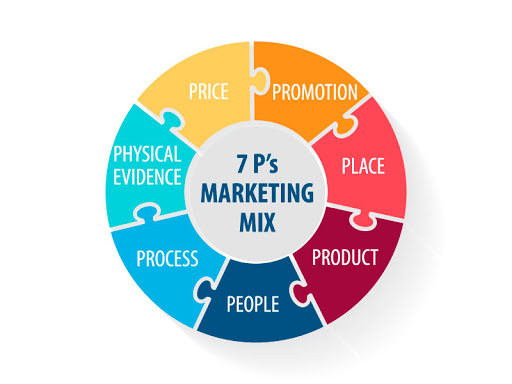
There are another 3Ps, Process, People, and Physical Evidence:
- People
The people (people) aspect here is both the target audience and those directly involved in providing business services.
Taking market surveys is important for you to assess your customers’ needs and tastes. Since then there are appropriate adjustments to service supply.
- Process
Processes are the processes and systems that help your business to provide services to the market.
You need to ensure your business has built a systematic system and process. Helping businesses save a large amount of costs in providing services to customers.
Process here can be the product delivery process, payment process (for customers). Or warehouse import-export system, logistic process,…
- Physical Evidence
In service marketing, facility is an aspect that needs to be mentioned. The physical environment here is the meeting space, contact, and exchange between service providers and customers. This is where customers use the service.
Physical Evidence can bring a big competitive advantage to businesses, helping them stand out in customers’ eyes.
SWOT Analysis

SWOT Analysis Definition
SWOT is the abbreviation of the first letters of the English words: Strengths, Weaknesses, Opportunities and Threats.
SWOT is a model that brings together all analysis of the external environmental factors and internal factors in the business of the business.
How Does SWOT Analysis Work?
Normally, SWOT diagrams are presented as a matrix of 4 squares representing 4 main elements. However, you can also list ideas for each item as a list. How to present it depends on each person.
For example, SWOT analysis in legal marketing involves identifying a clear picture of what your law firm can do well and its limitations. This process can help legal marketers get a unique client perspective.
After discussion, agree on the most complete SWOT version, listing the ideas of the 4 elements in order of highest priority to least priority.
I have also compiled a few questions for each section for your reference when doing SWOT analysis.
Strength
The first element of SWOT analysis is Strength.
This factor addresses the things the business is particularly good at, such as a good working environment, a unique sales idea, excellent human resources, excellent leadership, and so on.
Try asking questions to expand the first element by listing questions around the strengths of the business as follows:
- What do customers love about your business or products
- How does your business do better than others in the industry?
- What is the most attractive brand attribute of your business
- What unique selling ideas does your business have
- Or what resources only you have and your competition does not?
The answer will provide an overview to help you identify the core strengths of your business.
Don’t forget to consider the advantages of both the insider’s perspective, both the customer and the industry peers. If you’re having trouble, write down the company’s features, and you’ll probably find strengths from them.
Also, you need to think about your competition. For example, if all other competitors provide high-quality products even if you have a good product, that is not necessarily your advantage.
Weakness
Overconfidence in their strengths will become weaknesses for businesses, when businesses cannot see shortcomings that need to be changed.
Did you realize: What is causing your business plan to fail? The answer most likely comes from one or more weaknesses: the unqualified aspect of your company’s expertise, limited resources, unclear terms,…
Similarly, I have a few questions to help you find your weaknesses:
- What do your customers dislike about your business or products?
- What are the issues or complaints that are often mentioned in reviews about your business?
- Why did your client cancel the order or not complete / complete the transaction?
- What is the most negative brand attribute involved?
- What are the biggest obstacles / challenges in the current sales channel?
- What resources does your competitor have that you don’t?
For weaknesses, you must also have an objective and subjective overview: Are your competitors doing better than you? What weaknesses do other people see that you don’t recognize? Be honest and straightforward in dealing with your weaknesses.
Opportunities
Next in the SWOT analysis factors is Opportunities. Do you have a large number of potential customers created by your marketing team? That is an opportunity. Your business is developing a new, innovative idea that will open up a new “ocean”? That’s another chance.
Businesses can take advantage of the opportunities that come from:
- Trends in technology and markets
- Changes in government policy related to your sector
- Change in terms of society, population, lifestyle …
- Local events
- Trends of customers
Some of the questions that I suggest include:
- How can I improve the existing sales / customer support process or support potential customers?
- What types of communication will drive customer conversion?
- How can I find more brand advocacy gurus?
- What is the best approach for a more efficient inter-departmental workflow?
- Are there any other budgets, tools or resources that the business has not fully utilized?
- Or, which advertising channels are there potentials but businesses have not yet exploited?
Threats
The final element of a SWOT analysis is Threats but in general, everything that risks your likelihood of success or enterprise growth.
This risk can include factors such as emerging competitors, legal changes, risks in financial turnovers and almost anything else that could potentially hurt the future of the business or a business plan.
However, of course there will be many potential challenges or risks that businesses face, which cannot be foreseen, such as changes in the legal environment, market volatility, or even internal risks. Unreasonable salaries and bonuses hinder the development of businesses.
Marketing Environment
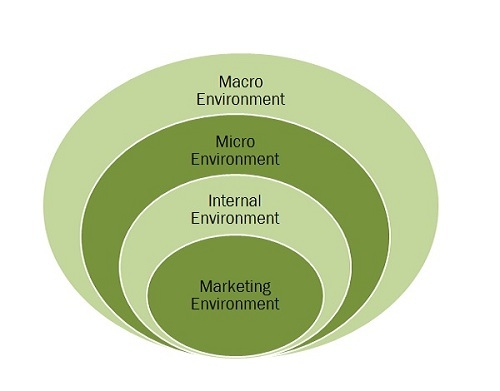
Marketing Environment Definition
Marketing environment is a combination of all factors, internal and external forces of an enterprise that have positive and negative effects on business marketing’s activities. The factors that make up the marketing environment are not only in the businesses, the company itself but also in its competitors and in the rest of the product industry.
It can be said that when analyzing the marketing environment, it is essentially analyzing the impact of factors in the business environment on the change of the nature, size, level … of market demand, on supply correlation, demand and, in particular, the company’s marketing-mix variables.
The marketing environment includes the macro environment and the micro environment.
Micro environments are forces that directly affect the company itself and its ability to serve customers: its suppliers, marketing brokers, customers, and competitors painting and direct public.
Macro environments are broader social forces that influence the micro environment, such as demographic, economic, natural, technical, political, and cultural factors. Let’s first talk about the corporate macro environment and then we will look at the micro environment.
How does Marketing Environment work?
The marketing environment is made up of the internal and external environments of the business. While the internal environment can be controlled, the business has little or no ability to control the external environment.
Internal Environment
A business’s internal environment encompasses all forces and factors within the organization that influence its marketing. These components can be grouped as follows:
- Human
- Finance
- Machines
- Supply of raw materials
- Market
The internal environment is under the control of the marketer and can be changed as the external environment changes. However, analyzing the internal marketing environment is just as important to the business as the analysis of the external marketing environment. This environment includes the sales department, marketing department, manufacturing unit, human resources department, etc.
External Environment
Micro marketing environment
The micro composition of the external environment includes external forces and factors that are directly related to the business. These include suppliers, market middlemen, customers, partners, competitors and the general public.
Suppliers include all the suppliers of raw materials and resources that businesses need. Market intermediaries include parties involved in the distribution of an enterprise’s products or services. Partners are all separate entities such as advertising agencies, market research organizations, banks and insurance companies, trucking companies, brokers, etc., that do business with enterprises. Customers include the business’s target audience. Competitors are businesses that enter a market that targets similar customers. The public is made up of any other group with a real or potential interest in a company’s ability to serve customers.
Macro marketing environment
The macro component of the marketing environment is also known as the coverage medium. It constitutes external factors and forces that affect the entire industry but do not directly affect the business. The macro environment can be divided into 6 parts.

Demographic Environment: Demographic environments are made up of market makers. It is described as the actual census and distinguishes the population according to their size, density, location, age, sex, race and occupation.
Economic Environment: The economy constitutes the factors affecting customers’ purchasing power and spending patterns. These factors include GDP, GNP, interest rates, inflation, income distribution, government funding and subsidies, and other important economic variables.
Physical Environment: The physical environment includes the natural environment in which the business operates. This includes climatic conditions, environmental changes, access to water and raw materials, natural disasters, pollution, etc.
Technological Environment: The technological environment constitutes technological innovation, research and development, technological alternatives, innovation innovations and technological barriers. Technology is one of the greatest resources of becoming an organization’s threat or opportunity.
Political-Legal Environment: The legal & political environment encompasses the laws and government policies prevailing in this country. It also includes pressure groups and other agencies that influence or restrict industry and business activities in society.
Social-Cultural Environment: The socio-cultural aspects of the macro environment include people’s lifestyles, values, cultures, prejudices and beliefs. This differs from region to region.
Communication Mix
Communication Mix Definition
In addition to implementing a good product, pricing attractively and reaching its target audience, businesses also have to communicate with their target customers. However, the information that needs to be communicated to the target customer has to go through many stages under different forms of communication by different communicators.
The firm communicates with its various middlemen, consumers, and public groups. These middlemen communicate with their various customers and public groups. Consumers also communicate with each other and the public through word of mouth. At the same time, each group provides feedback to other groups.
How does Communication Mix work?
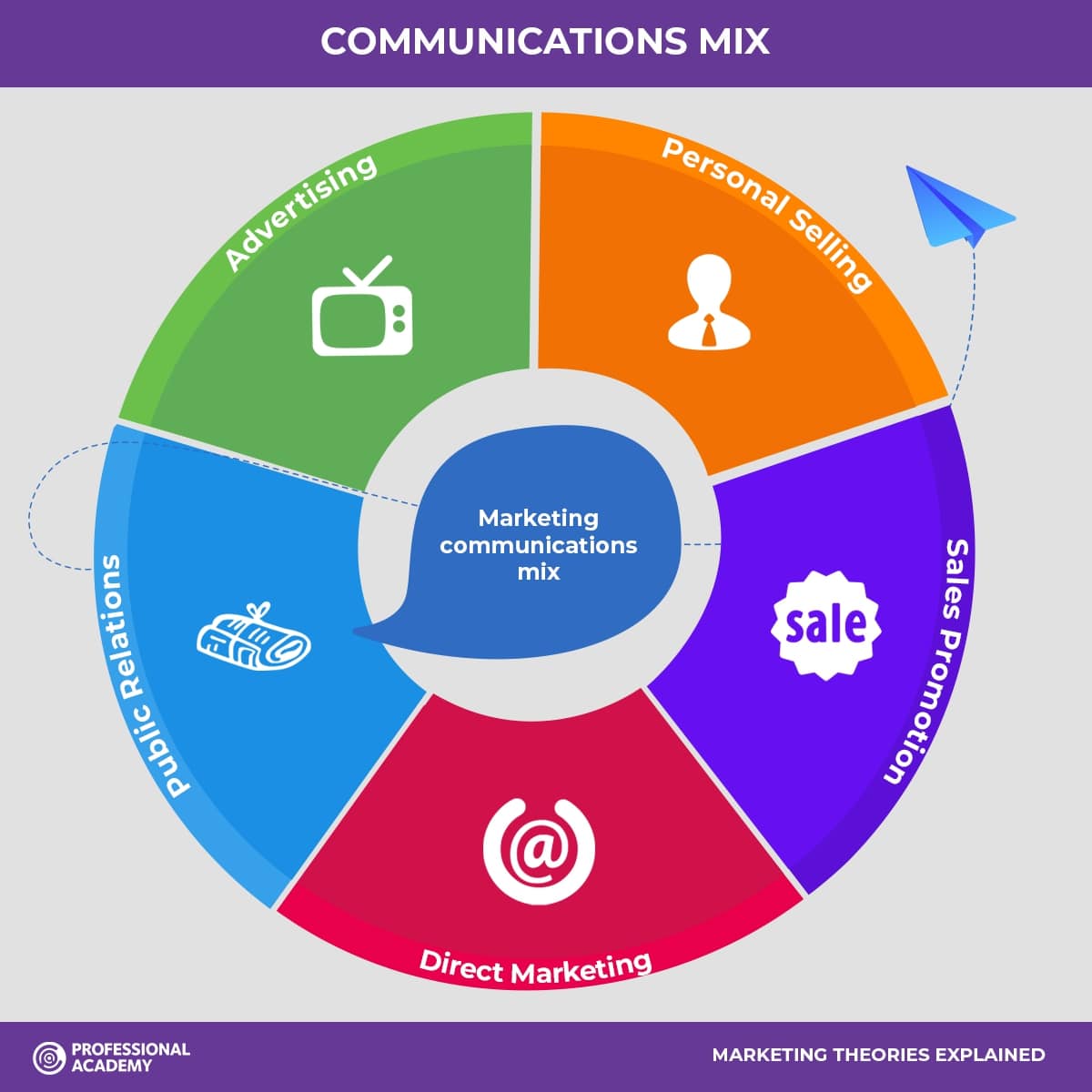
The marketing communication system, also known as the promotion mix system, consists of five main tools:
-
Advertising is any form of indirect introduction and promotion of ideas, products or services, spent by a certain person (organization) who wants to advertise.
-
Direct marketing is the use of mail, telephone and other indirect communication tools to inform existing customers and potential customers or to request a response.
-
Sales promotions are short-term incentives in the form of rewards to encourage trying or buying a product or service.
-
Public relations include various programs designed to enhance or / and protect the image of a business or certain products and services.
-
Personal selling is a form of direct communication with prospective customers for the purpose of selling.
Maslow’s Hierarchy of Needs

Maslow’s Hierarchy of Needs Definition
Maslow’s hierarchy of needs is the theory of dynamism in psychology, consisting of a 5-tier model of a pyramid that expresses human’s natural needs developing from basic needs to higher need: physiological -> safety -> love/belonging -> esteem -> self - actualization.
Physiological needs
Physiological needs are the most basic needs, which must be met for people to live, survive, and work towards the next needs in Maslow’s pyramid of needs.
Physiological needs include needs such as breathing, food, water, clothing, shelter … When these needs are satisfied, people can function and develop well.
This is considered the basic and most important need because if this need is not met, all of the above needs will not be able to be fulfilled.
Safety needs
The next need that Maslow addresses in this pyramid of needs is safety. This is completely reasonable because the physiological need to help people survive, then they need something to ensure to maintain and help them more secure to develop.
Safety needs include Safe for health, Financial safety, Safety of life, Love/Belonging needs.
When their basic needs are fully met, they begin to expand their relationships, such as friendship, love, partner, co-workers. This need is expressed through connections, such as family, friends, lovers, clubs, etc., to create a sense of intimacy, closeness, and help people feel alone, depressed, or anxious.
Esteem needs
At this level, human need refers to wanting to be valued and accepted by others. They started their efforts, trying to be recognized by others. This need is reflected in a person’s self-esteem, self-confidence, confidence, trust, and success level.
The respected need in Maslow’s demand tower is divided into two categories:
Desire for reputation, respect from others: it is shown through the reputation, position, position that others achieve in society or in a certain organization or collective.
Self-esteem: this is an extremely important factor for personal development; it is reflected in the self-esteem of one’s own dignity and morality. A person who lacks self-esteem can easily lead to guilt, often feeling anxious about life’s difficult things.
Usually, people who have received respect and recognition from others tend to respect themselves, be confident and proud of their abilities.
To achieve this need of respect, people need to try and make efforts to develop themselves and their expertise. Achievements and results that deserve a contribution will make others respect them more. This need is most evident in trying to advance at work.
Self-actualization needs
This is the highest human need; it is located at the top of Maslow’s need tower. When you satisfy all your needs at the four levels below, the need to express yourself to be recognized begins to appear. And Maslow said that this need does not come from the lack of something like the 4 above needs, but it comes from the desire to develop people.
This need often appears in successful people, they continue to promote their potentials, strengths and intellect for others to see. Most of these people work to satisfy their passion, to find values that truly belong to them. Therefore, if this need is not met, people will regret that their passions have not been fulfilled.
This need is reflected in the fact that people can give up a job that offers a high status, reputation and attractive salary to do jobs they love and love.
Most of us have all 5 of these needs. However, depending on each individual, the needs are more or less and in each stage the needs will be different.
How Does It Work?
Maslow’s Hierarchy of Needs is widely used in business administration and human resource management. These two industries help businesses understand what their employees are looking to exploit and manage human resources effectively.
Besides, in Marketing, Maslow’s Hierarchy of Needs also provides practical support in researching consumers’ behavior and needs. As follows:
Most good marketers understand that you need to understand who your target audience is and what they want before you come up with a well-crafted marketing plan. In other words, they need to understand customer insight. When you do this, you will understand what customers like or dislike to have the right marketing strategy.
Therefore, Maslow’s needs pyramid is applied in Marketing with the following purposes:
-
Positioning customer segments: for each different customer group they will have different purposes and product needs. So you need to know the needs of the target audience of the business located in any segment to have the most appropriate marketing.
-
Researching customer behavior to convey the message: After identifying the target customer segment, the next task is to study customer behavior. In this segment, you need to know what factors will affect the customer’s buying decision: preferences, price, social status, or usability. Once you do this, it will be easier for you to do research messages tailored to customer needs.
For example: You trade in a mid-range car product, targeting households. If you choose the speed or the luxury as the advantage of the product is completely wrong. Because the target customer’s needs are at the physiological and safety needs level, the problem they are concerned with when buying a car is a reasonable price, gas savings, and comfort.
Or, with this car, but you choose to target customers who are merchants, can you sell products or not? Unlike the target audience above, this customer group’s need has begun to shift to the level of need to be respected and expressed. So, what they need in a car is the level of luxury, class and brand.
Market Segmentation

Market Segmentation Definition
Market Segmentation is the division of your visitors and customers into segments or groups based on common characteristics. There are countless ways to divide your customers into groups. That’s why defining your own niche can - and probably will - be different from your competitors.
Here are a few examples of customer segments that create different groups of customers:
- VIP: customers who shop most often or spend the most money.
- Longtime active users are recurring customers.
- The new customer is reactivated, made a purchase, then deactivated for a while, and then made another purchase.
- Consumers are low-end, shop less, and spend less.
- New customers have just made their first purchase.
- New visitors just signed up for your mailing list without making a purchase.
How does Market Segmentation work?
Data collection
First, it’s time to collect data so you can use that data to shape your market segments. There are many ways to go about it. Some people like to go with pre-made lead lists; others like to do your own research. If you fall into the following category (perhaps you should), you can frame your searches along with the following categories.
Research by company size
Size can mean a number of things, but is usually measured by the number of employees, the number of customers, or the overall sales of sales that a company claims. Some companies have transparency on their websites, which makes it much easier to reach the right people. Using free references like Bloomberg can help uncover the basics of a company in question.
Research by industry
It is unlikely that your product is applicable to all industries, which is why the industry segment exists. Segmentation will help you ensure that you don’t waste time by targeting a company with no demand for your product.
Research by location
If you are offering a location-specific product or service, like a scene creation service in your local community, your geographic market segmentation can be quite discreet: You can use tools handy as potential customer maps and join local marketing whenever possible. For other industries, like IT staff, your accessibility could be international. Whatever your product, location is important to know about the company, because it will help you decide which sales tactics to use and when to send emails if you communicate across time zones …
Research on demand
This segmentation approach requires companies to qualify based on whether they need your product or service. Although this definition is simple, the process behind this decision may not be, depending on what you offer. If you sell a scene creation service, you can use Google Maps to look up the company’s headquarters.
Capture data in web forms
Web forms are the industry standard for collecting potential customer data. The practice is simple: if you have high-quality content that will provide a lot of value to your website visitors, you can put that content behind a web form that asks users to submit a name, email address and other information before they can see it. And if you don’t have noteworthy content yet, you should equip your writers with any of the AI copywriting tools out there and produce valuable pieces that you can use.. The form questions should be light and non-invasive to not keep the user from filling it out but constructive enough to give you enough context when communicating with them in the future.
Survey
As part of a niche marketing approach, surveys can be cleverly deployed to get highly specific information from potential buyers in exchange for very specific content or rewards. A standard survey format typically offers a tangible reward, such as a gift card or a free product, in exchange for large amounts of voluntary user data. Although somewhat abstract, surveys are still one of the best methods for obtaining metamorphic data about users and companies.
Arrange the data into segments
There are many ways to go about this process. Most involve analysts and lots of time. Although the DIY route is faster, it is not a substitute for a comprehensive market segmentation strategy. Assuming time and money are a hindrance, you can estimate your niche by aggregating your data into a single source and running filters on it to group leads. and your companies by segments.
Remember, ask yourself the following:
- Is this segment measurable?
- Is this segment large enough to make a profit?
- Is this segment stable and won’t go away after a short while?
- Is this segment accessible to my marketing strategies?
- Is this segment homogeneous, and will they respond similarly to my marketing strategies?
Fix your marketing channels
Now that your segments are firmly established, it’s time to incorporate channels into your marketing. This means setting up a plan for each of your marketing tools and channels and coming up with real ways to reach your segments with them. You will attribute different sales and marketing tactics to each stage and determine what is involved in your marketing channels. The good news is that your market segments are well defined and you should be able to talk to them clearly. The real challenge is continuously improving your efforts with trial and error to get the best conversion rate possible.
The 12 Brand Archetypes
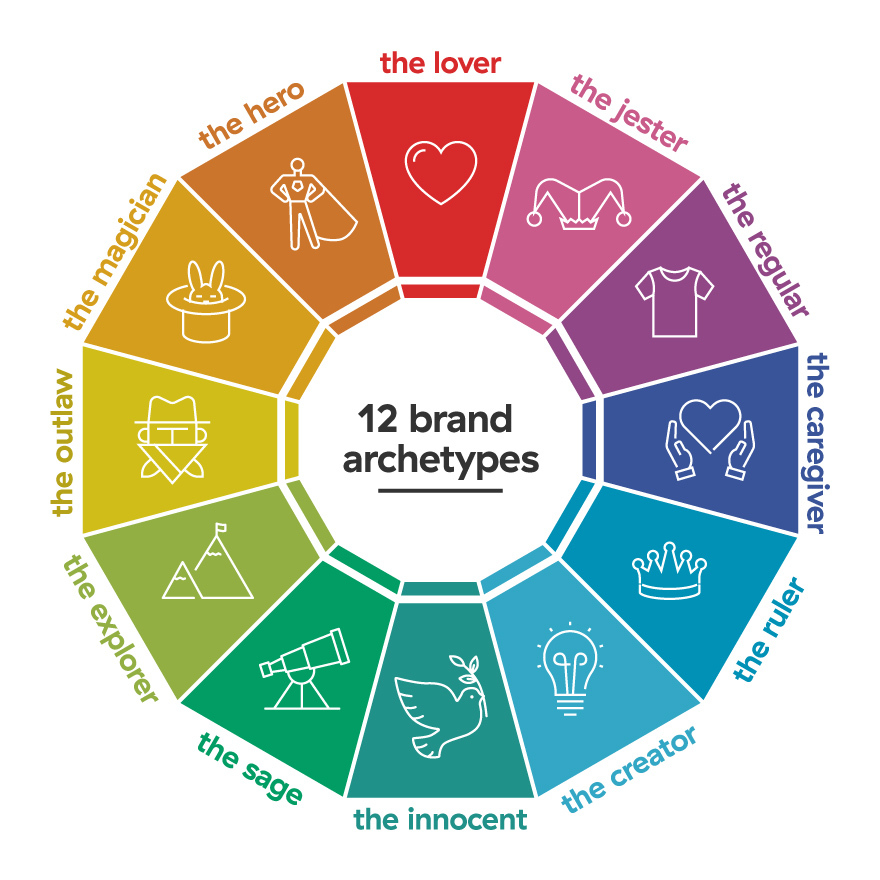
The 12 Brand Archetypes Definition
Archetype is the term given by the Swiss psychologist Carl Jung in his theory that humans have 12 basic patterns. Each of these archetypes will have unique personality traits, values, attitudes, and behaviors.
Marketing, advertising and branding have applied this model to create a brand model for businesses. The idea of turning a brand - an invisible object into one of 12 archetypes will help bring the brand soul and bring it into people’s lives.
From a customer perspective, we connect to the characteristics and characteristics of each Brand Archetype. It represents the most basic needs and wants of each person, contributing to bringing customers and brands closer together.
How Does Brand Archetypes Work?
There are a total of 12 basic archetypes. Choosing a suitable brand model is extremely necessary, helping the brand strategy of businesses. But first, you need to understand and capture the roles in creating deep relationships with customers in your target market.
The Innocent
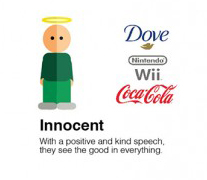
Goal: Bring a sense of happiness
Characteristics: Being a model striving for goodness, purity, youthfulness, optimism, simplicity, morality, romance, and loyalty.
Cons: A bit too honest and boring
Marketing niche: Business with deep values, bringing trust, trustworthiness, and honesty, directly related to ethics, simplicity and perhaps even nostalgia.
Examples: Dove, Coca-Cola
The Regular Guy

Goal: To connect with others
Characteristics: Friendly, supportive, loyal, who can share, connect
Cons: Can lack outstanding features
Marketing niche: The business has the characteristics of belonging, ownership, and attachment
Example: Home Depot, eBay
The Hero
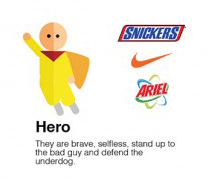
Objective: To help society and the world
Characteristics: Courageous, bold, respectable, strong, confident, and inspiring.
Cons: Arrogant and aloof
Marketing niche: Create a positive effect in the world, solve big problems, or inspire the community.
Examples: Nike, BMW, Duracell
The Outlaw
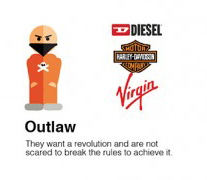
Goal: Break the rules, fight with the government
Characteristics: Rebellious, iconic, wild, paving the way for change
Cons: Can be considered adverse effects
Marketing niche: Representation of change, the role model of Robin Hood, allowing for adventure and breaking the rules
Examples: Harley-Davidson, Virgin (Richard Branson)
The Explorer
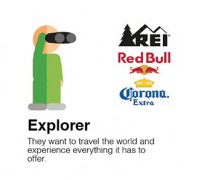
Objectives: Finding new experiences
Characteristics: Non-stop, adventurous, ambitious, individualistic, independent, pioneering.
Cons: May not match the mainstream
Marketing niche: Exciting, adventurous, exploring
Examples: Indiana Jones, Jeep, and Red Bull
The Creator
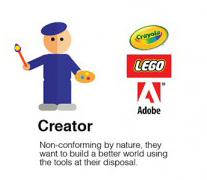
Objective: Create things of lasting value and lasting significance.
Characteristics: Creative, imaginative, artistic, entrepreneurial
Cons: Possibly perfection or too far away from reality.
Marketing niche: Bringing vision, helping customers express their creativity and nurture their imagination
Examples: Lego, Crayola
The Ruler
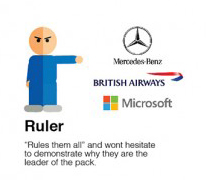
Objective: Control, establish order from chaos
Characteristics: Leadership, accountability, organizational ability, model management, administrator.
Cons: Can be a bit out of control
Marketing niche: Help people manage, manage better, arrange more stable, and secure in a chaotic world.
Examples: Microsoft, Barclays, Mercedes-Benz
The Magician

Goals: Make dreams come true, create special things
Characteristics: Dreamy, charismatic, imaginative, idealistic, spiritual
Cons: Weak results because of the risk
Marketing niche: Help people change worldview, inspire change, expand awareness, awareness
Examples: Disney, Wizard of Oz, Apple
The Lover

Goal: Create intimacy, inspire love
Characteristics: Passionate, sexy, intimate, romantic, warm, committed, ideal
Cons: Can be too dreamy, not grounded enough
Marketing niche: Help people feel appreciated, belong, connect, enjoy intimacy, build relationships
Examples: Victoria’s Secret, Godiva Chocolate
The Caregiver

Objective: Care and protect people around
Characteristics: Caring, nurturing, selfless, generous, compassionate
Disadvantage: exploited or exploited
Marketing niche: Help people take care of themselves, serve the community through health care programs, education or rescue aid.
Examples: Mother Teresa, Johnson & Johnson, and Heinz
The Jester
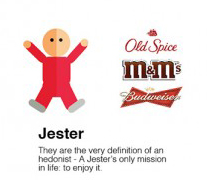
Goal: Bring joy to everyone
Characteristics: Cheerful, humorous, gentle, playful
Cons: Can be seen as frivolous or disrespectful.
Marketing niche: Help people have a good time, enjoy what they’re doing, and evoke impulsiveness, spontaneity
Examples: Motley Fool, Ben & Jerry’s, IKEA
The Sage
Objective: To help the world have more wisdom and understanding
Characteristics: Knowledge, wisdom, understanding, thoughtful, analytical, advisory, reliable
Cons: Can be overly conservative and overthinking
Marketing niche: Help people better understand each specific issue, provide analytics.
For example: BBC, PBS, Google, Philips
Conclusion
Overall, the 7 marketing theories above are completely applicable since they are based on true facts. Any marketers need to take these theories into consideration as each of them gives different kinds of keys for communicating with customers and provides valuable insight into target customers’ behaviors.
New Posts

How To Set Up Google Analytics 4 For Your BigCommerce Store






